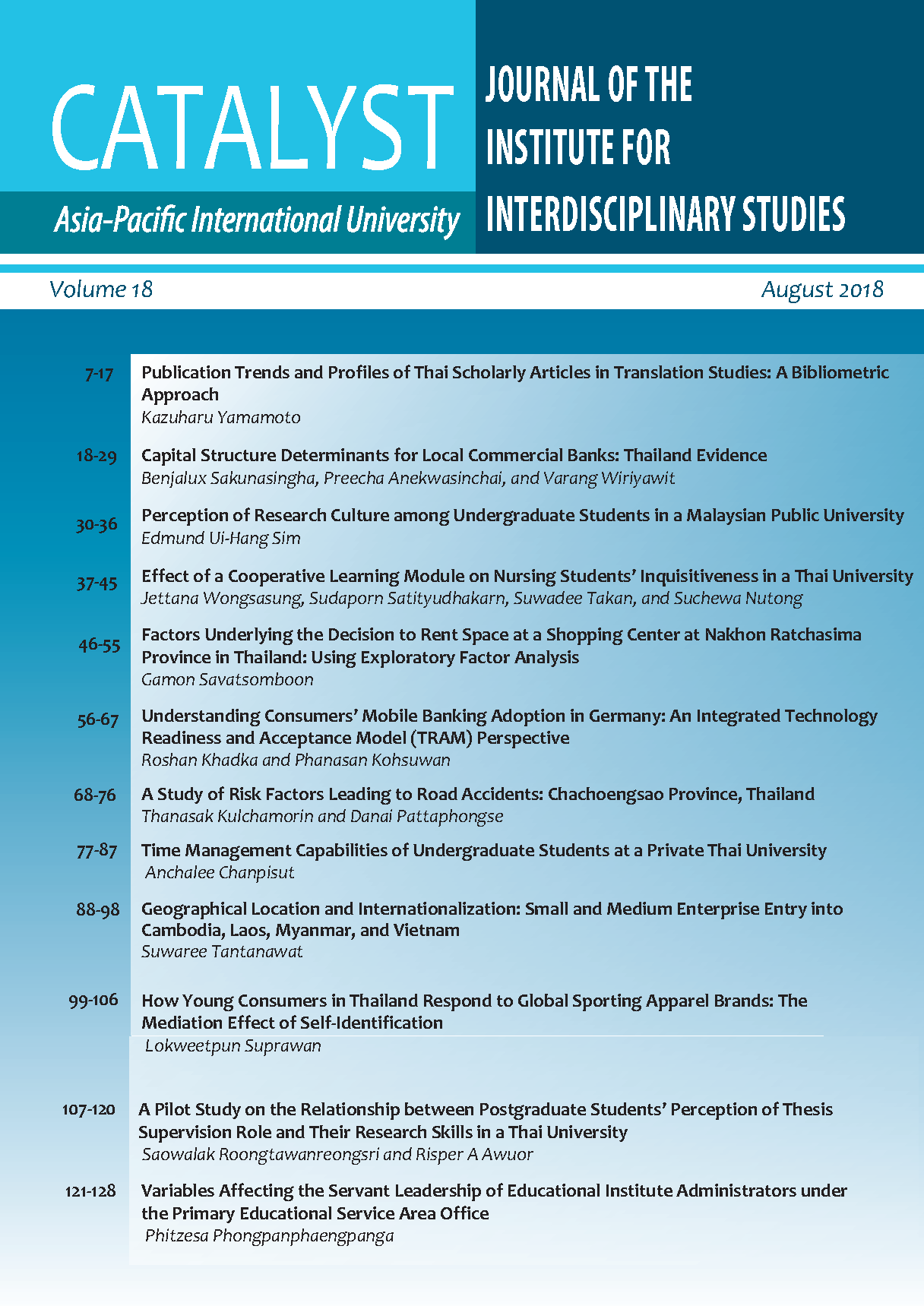How Young Consumers in Thailand Respond to Global Sporting Apparel Brands: The Mediation Effect of Self-Identification
Main Article Content
Abstract
Competition in global markets is not only fierce, with rivalry among various brands in the same industry, but also because of the threat of an increasing number of counterfeit products. The concept of brand equity studies how brands may become more prominent in the marketplace. Thus, this study investigates the causal relationships of (i) brand awareness and brand image and; (ii) brand image and self-identification with global consumer culture. This study also examined the mediation effect of self-identification with global consumer culture on the relationship of brand image and loyalty. The research was conducted on 276 young Thai consumers asking about global sporting apparel brands. The statistical analysis used for hypothesis testing was regression analysis, with mediation testing included. The findings suggest that the relationship of brand awareness and brand image is a causal relationship, indicating that stronger brand awareness will lead to stronger brand image. It was also found that brand image will influence consumer self-identification with global consumer culture for global sporting apparel brands. Finally, the mediation effect of self-identification with global consumer culture on the relationship between brand image and brand loyalty was found to be fully mediated.
Article Details

This work is licensed under a Creative Commons Attribution-NonCommercial-NoDerivatives 4.0 International License.
Copyright: Asia-Pacific International University reserve exclusive rights to publish, reproduce and distribute the manuscript and all contents therein.
References
Ashforth, B., & Mael, F. (1989). Social Identity Theory and the Organization. Academy of Management Review, 14(1), 20-39.
Baron, R., & Kenny, D. (1986). The Moderator-Mediator Variable Distinction in Social Psychological Research: Conceptual, Strategic, and Statistical Considerations. Journal of Personality and Social Psychology, 51(6), 1173-1182.
Chiu, W., Lee, K., & Won, D. (2014). Consumer behavior toward counterfeit sporting goods. Social Behavior and Personality: an International Journal, 42(4), 615-624.
Esch, F., Langner, T., Schmitt, B., & Geus, P. (2006). Are brands forever? How brand knowledge and relationships affect current and future purchases. Journal of Product & Brand Management, 15(2), 98-105.
Field, A. (2005). Discovering statistics using SPSS (Second Edition ed.). London: SAGE Publications
Frank, P., & Watchravesringkan, K. (2016). Exploring antecedents and consequences of young consumers' perceived global brand equity. Journal of Product & Brand Management, 25(2), 160-170.
Frazier, P., Tix, A., & Barron, K. (2004). Testing Moderator and Mediator Effects in Counseling Psychology Research. Journal of Counseling Psychology, 51(1), 115-134.
Gerke, A., Chanavat, N., & Benson-Rea, M. (2014). How can Country-of-Origin image be leveraged to create global sporting goods brands? Sport Management Review, 17(2), 174-189.
Kapferer, J. (2004). The new strategic brand management: Creating and sustaining brand equity long term (3rd ed.). London: Kogan Page.
Keller, K. (1993). Conceptualizing, Measuring, and Managing Customer-Based Brand Equity. Journal of Marketing, 57(1), 1-22.
Keller, K. (2008). Strategic brand management: Building, measuring, and managing brand equity (3rd ed.). Upper Saddle River, NJ: Pearson Education, Inc.
Kim, C., Han, D., & Park, S. (2001). The effect of brand personality and brand identification on brand loyalty: Applying the theory of social identification. Japanese Psychological Research, 43(4), 195-206.
Kuenzel, S., & Halliday, S. (2010). The chain of effects from reputation and brand personality congruence to brand loyalty: The role of brand identification. Journal of Targeting, Measurement and Analysis for Marketing, 18(3-4), 167-176.
Macdonald, E., & Sharp, B. (2003). Management perceptions of the importance of brand awareness as an indication of advertising effectiveness. Marketing Bulletin, 14(2), 1-11.
Martínez, P. (2015). Customer loyalty: exploring its antecedents from a green marketing perspective. International Journal of Contemporary Hospitality Management, 27(5), 896-917.
Nunnally, J., & Bernstein, I. (1994). Psychometric theory (3rd ed.). New York: McGraw-Hill.
Rageh Ismail, A., & Spinelli, G. (2012). Effects of brand love, personality and image on word of mouth: The case of fashion brands among young consumers. Journal of Fashion Marketing and Management: An International Journal, 16(4), 386-398.
Riketta, M. (2005). Organizational Identification: A Meta-Analysis. Journal of Vocational Behavior, 66(2), 358384.
Tajfel, H. (1974). Social Identity and Intergroup Behaviour. Social Science Information, 13(2), 65-93.
Turner, J., Hogg, M., Oakes, P., Reicher, S., & Wetherell, M. (1987). Rediscovering the social group: a Selfcategorization theory. Oxford: Basil Blackwell.
Weisheng, C., & Keat, L. (2016). Consumers’ intention to purchase counterfeit sporting goods in Singapore and Taiwan. Asia Pacific Journal of Marketing and Logistics, 28(1), 23-36. doi: doi:10.1108/APJML-02-20150031

